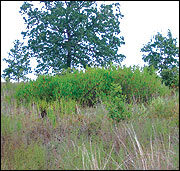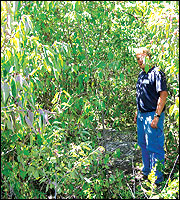Dogwoods, shrub
- Cornus spp.
- Gray dogwood, Redosier dogwood, Roughleaf dogwood, Silky dogwood, Stiff dogwood, Swamp dogwood
Woody
Shrub dogwoods are common in fence lines and along forest edges. Individual plants are rather short (less than 12 feet tall) and somewhat rounded.
Scott Sudkamp, Missouri Department of Conservation
Description
These dogwoods are thicket-forming shrubs that can grow up to 12 feet tall. Stems consist of many irregular branched and interlaced twigs that form a dense canopy. Flowers are borne in terminal, long-stalked clusters, which develop into white to gray, globe-shaped fruits that mature in autumn. The leaves are simple, opposite and egg- to lance-shaped. Shrub dogwoods occur throughout the Midwest on many soil types and moisture regimes.
Bloom period
May to July
Use by bobwhites
Shrub dogwoods — particularly roughleaf dogwood, gray dogwood and swamp dogwood — serve as excellent covey headquarters. The dense canopy afforded by the tightly interlaced twigs provides a nearly impenetrable barrier to avian predators. The closed, shaded canopy also reduces the amount of ground vegetation, providing essential bare ground and relief from summer heat. In fall, bobwhites readily consume the seeds. During winter, the tightly woven twigs reduce snow and ice accumulation. Shrub dogwoods and American plum should be familiar to any land manager with an interest in providing high-quality habitat for bobwhites.







